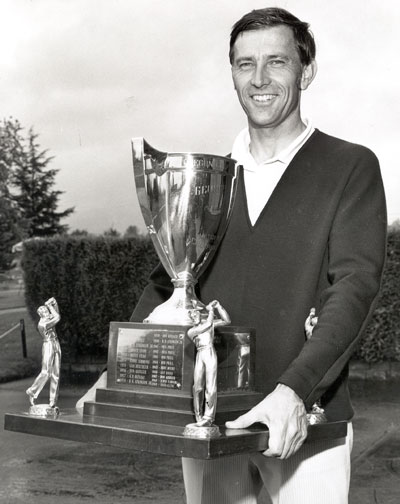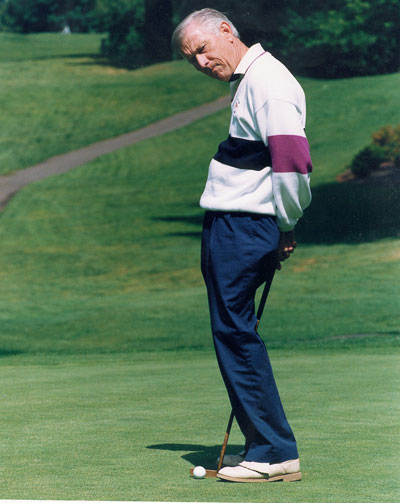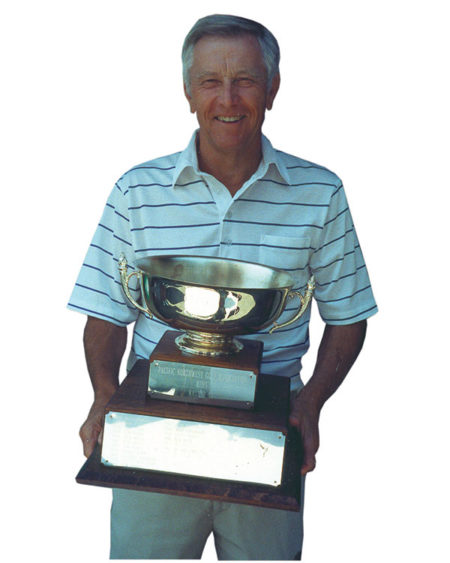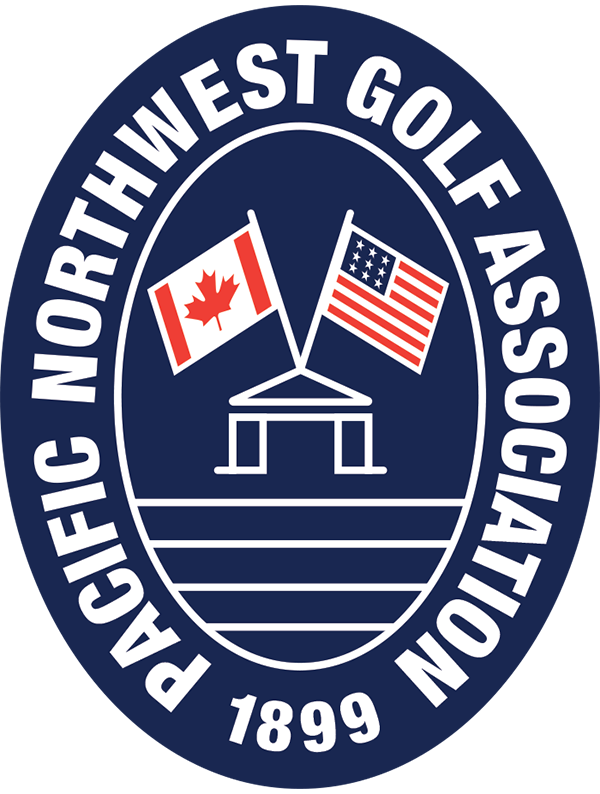Kent Myers – Hall of Famer, and one of a kind
Kent Myers, who collected 150 victories during a long amateur career that led to his induction into the Pacific Northwest Golf Hall of Fame, passed away on December 30, 2021. He had just finished hitting a bucket of balls on a driving range in Scottsdale, Ariz., and fell of a heart attack. He was 89.

Myers was introduced to golf as a junior at North Salem High School in Oregon. He took an interest in the game after he was given a set of Stan Thompson persimmon woods and Bobby Jones irons by a teacher at North Salem. The teacher’s son had used them before he was killed in World War II. Myers said he “felt an obligation to play the game” after receiving the clubs.
Myers played his first rounds of golf with a future head professional at Salem Golf Club, Paus Sundin. Another golfing partner was Loren Lippert, who, by age 67 in 1998, had played over 1,000 different golf courses, including all of them in the Pacific Northwest. As high school students, the three would jump into Lippert’s car and venture off to nearby golf courses. Other good golfers out of North Salem High School during this period included Gene “Bunny” Mason, a long-time club pro before becoming a prolific golf course architect in the Northwest, future PGA Tour player Patrick Fitzsimons, title-winning Northwest professional Chuck Milne, and Bob Prall, a two-time winner of the Oregon Amateur.
Myers attended Willamette University, where he was a Northwest Conference golf champion. After getting his Masters degree at Willamette, Myers taught school in Albany, Oregon, then served in the U.S. Army from 1956 to 1958. After his discharge from the Army, Myers worked as a school district psychologist for Grays Harbor County, then attended Stanford University where he earned a doctorate in school administration.
During his three years at Stanford, Myers didn’t play golf. But eventually launched a career that would span four decades, and lead him to become one of the region’s most decorated amateurs. Myers called himself “a late bloomer, because I worked in my early years.”
In 1956 Myers qualified to play in the U.S. Open at Oak Hill Country Club in Rochester, New York. This event would be the first of 11 USGA championships Myers played between 1956 and 1996; the others included a U.S. Senior Open, three U.S. Amateurs, and six U.S. Senior Amateurs.

Myers enjoyed a long and successful career as an educator, retiring in 1991 as the assistant superintendent of the Bend, Oregon, school district.
Myers eschewed the life of a golf professional. “I debated that. But I wanted to get my education and raise a family.” He and his wife, Joan Marie, raised four daughters, Sally, Laura, Jill and Jane. Kent had his daughters caddie for him at golf tournaments. On occasion, this tradition-bending precedent was not easy. “My daughters all caddied for me, and they were probably the first female caddies in the Northwest,” Kent said. “There were some clubs – San Francisco Golf Club, Los Angeles Country Club and the Olympic Club in San Francisco were a few – where I had to argue with officials to have them allow my daughters to caddie.”
A true competitor who loved the mano-a-mano of match play, Myers was brilliant in the annual Hudson Cup competitions, which are conducted in the Ryder Cup-style match-play format, and for which he was selected 19 times as a team member, 18 of which he also served as captain.
Myers’ lengthy amateur career is also illustrated by his place on the Senior Hudson Cup Amateur Team. He helped his team defeat its professional opponents in 1993 and 1997. He played on the inaugural Senior Hudson Cup Team in 1992, and was its captain in 1998. Myers was named the Hudson Cup Charles Congdon Award Winner in 1965, 1974 and 1980. The award, which signifies the most valuable amateur, is voted on by members of the professional team.
Myers was fearless on the course, even going so far as to try unconventional approaches to the game, such as his between-the-legs putting stroke.
In the semifinals of the 1965 Oregon Amateur, Myers was 3-down after 27 holes to Bruce Cudd. But he turned the match his way at the 28th hole by switching to his unique putting style, which he used from time to time because he said, “I was good at it.” With it, Myers holds the putter behind his back and extends the shaft down between his legs. Many observers felt Myers used his behind-the-back putting method to rattle an opponent. But Myers demurs on this account. “I didn’t use that stroke to shake people up. After all, if I didn’t make the putts I’d look foolish. But if I make them and it shakes people up, there’s nothing I can do about that.” Regardless, in his match with Cudd, Myers sank a 10-footer to birdie the 28th hole, and Cudd’s game came unglued. Myers won the 28th, 29th and 30th holes before going on to win the match.

Myers got the idea for his “optional” putting style while stationed in the Army in Texas in 1956. He’d been winning a lot of money on the putting greens used by military personnel, who then banned him from the games. So Myers experimented with the behind-the-back technique, and asked his buddies if he could rejoin the putting games if he putted that way. The others acquiesced and let him back in the competitions. “It wasn’t long before I was winning all the money that way, too.”
His unique putting style gained notoriety in 1967 at the inaugural Pacific Coast Amateur Championship, held at Seattle Golf Club. Joe Dey, the USGA’s legendary executive director for many years, spent a day at the event. “I was putting on the 16th green and I knocked in a 20-footer behind my back,” recalled Myers. “Someone in the gallery yelled, ‘I thought I got ’em all!’ It was Dey, who recently had banned (Portland golf pro) Bob Duden’s croquet-style putter and was cracking down on alternative styles of putting. Dey called me in afterwards and interviewed me. They (USGA officials) took my picture and it appeared in the USGA’s Golf Journal. They weren’t miffed, but Dey thought it highly unusual and warranted being in Golf Journal.”
One year, Golf Digest did an article on the putting styles of several noteworthy golfers. Myers said, “They had Nicklaus and other top pros, each getting a half page of explanation and a photo. They devoted a full page to my behind-the-back style.”
In the 1991 U.S. Senior Open at Oakland Hills Country Club in Birmingham, Michigan, Myers was faced with a 20-foot side-hill putt on the slick 18th green. “The spectator stands by the green were full,” he recalled. “I thought, ‘What the heck, I’ll only get here once.’ Darned if I didn’t make it. One guy in the crowd yelled, ‘That was worth the price of admission!’”
Something of a Renaissance man, Myers also wrote a book about all the golf courses in Oregon entitled “Golf in Oregon,” published in 1977. In 2011, he was given the “Local Legend” award by the Northwest Golf Media Association, and in his acceptance speech to the gathered sportswriters he read from his latest book of poetry he had just published.
He will be missed.
Kent Myers’ golf accomplishments
- PNGA Men’s Amateur Championship Finalist – 1968 & 1987
- PNGA Senior Men’s Amateur Champion – 1992
- PNGA Men’s Master-40 Amateur Champion – 1994
- Oregon Men’s Amateur Champion – 1965, 1972, 1981 & 1983
- Morse Cup – 19-time team member
- Hudson Cup – 19-time team member; 18-time team captain
- Hudson Cup Charles Congdon Award Winner – 1965, 1974 & 1980
- Senior Hudson Cup – 5-time team member; team captain in 1998
- Qualified for 11 USGA national championships
- 1956 U.S. Open
- 1991 U.S. Senior Open
- Three U.S. Amateurs
- Six U.S. Senior Amateurs
- Inducted into Willamette University Athletic Hall of Fame – 1994
- Inducted into Pacific Northwest Golf Hall of Fame – 2001
Some of the material in this brief bio of Kent Myers is taken from the book, “Championships & Friendships,” the centennial history book of the PNGA, published in 1999 by the PNGA and co-written by Michael Riste and Jeff Shelley. More info on Myers can be found on the PNGA’s Hall of Fame page.





